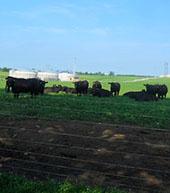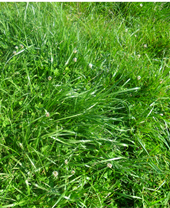Minimize and Reduce Soil Compaction

Soil compaction is a common problem that many producers face but that is often overlooked. Significant soil compaction can also reduce forage yields and slow forage establishment, which, in the long run, costs money. Management practices can be used to reduce and correct this problem while improving soil conditions.
Soil compaction negatively affects the soil and growing vegetation. Soil particles are pressed together, reducing pore space and aeration. The damage to the soil structure reduces the soils’ ability to hold and conduct water, nutrients, and oxygen. Rate of water infiltration is decreased and more water is lost to runoff. Other effects of compaction include decreased organic matter, reduced microbial activity, poor drainage, increased erosion, and nutrient leaching. These undesirable effects on the soil directly affect plant growth. Roots have increased difficulty when penetrating the soil, which often results in reduced root growth and reduced ability to take up water and nutrients. The decreased aeration and gas exchange can hinder root metabolism. Compacted soils can slow forage establishment, cause short and stunted plants, decrease drought tolerance, and reduce overall yields. Severely compacted areas often have sparse growth or are bare due to these problems.
Soil compaction can be created from both natural causes and operational functions. Severe compaction is almost always created through management practices. Natural compaction is produced by raindrop impact, which can form a thin crust on the soil surface. This crust is usually less than ½” thick but may reduce seedling emergence. Management sources come from traffic and tillage. Wheel traffic is a main contributor of soil compaction issues. As farm equipment has become heavier over time and producers' time has become more limited, this problem has increased. Tillage operations at the same depth over time can also cause severe compaction of the soil layers below tillage depth. Wet soils are the most susceptible to compaction. Spring planting and haying operations are often performed on wet soils. Busy schedules and smaller windows of time to perform these procedures make waiting for optimal soil moisture difficult. Hoof traffic is another cause of compaction, especially near waters, feeders, and gates.

Simple steps can be taken to prevent and reduce the severity of soil compaction. Knowing the soil type and soil properties is useful when making management decisions. Potential for compaction is increased in soils high in clay and low in organic matter. Building organic matter in the soil promotes development of good soil structure while decreasing soil bulk density. Keeping a thick stand of forages, increasing manure distribution, and reducing tillage can build soil organic matter. Reducing or eliminating tillage, which breaks down the soil structure, reduces organic matter and microbial activity, and reduces plant residue on soil surface, is extremely beneficial. If tillage is necessary, alter tillage depth over time. Controlling and reducing wheel traffic, especially on wet soils, is vital. Planting a tillage radish in severely compacted areas is another way to reduce compaction. Not only does this crop provide thick ground cover, but its large tap roots can penetrate compacted soils. Plant a “forage type” radish if you will be grazing. These have almost as much root as the Diaken (or tillage) type but have more top growth for grazing. Forage radishes are often planted in a mixture with annual ryegrass or cereal rye. Consider installing high-traffic pads around waters, feeders, and gates. Regularly moving feeding areas can prevent these areas from becoming severely compacted. Also, consider using a sacrifice lot during extremely wet periods. For more information on high-traffic pads, see Using Soil-Cement on Horse and Livestock Farms, Using Dry Lots to Conserve Pastures and Reduce Pollution Potential, and High Traffic Area Pads for Horses.
Categories:
General
Environment


